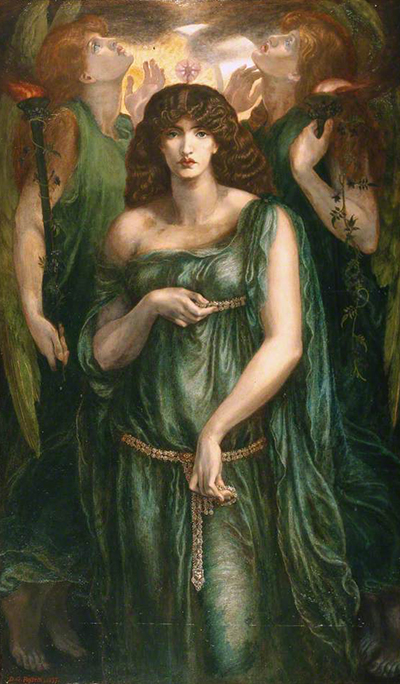This painting was done sometime back in 1877 and belonged to the latter part of Gabriel’s career. The portrait features a full-length figure of a woman dressed in sea-green robes, gazing towards the viewer. Astarte Syriaca has long, thick and wavy flowing hair that flows on her back. The woman has one of her legs placed forward to look as if she is striding towards the viewer.
On the other hand, she is pictured holding an ornate floral metal strap with her left hand under her chest. Her left hand seems to be holding a similar strap that rests around the hips area. Both her hands, the limbs, and her breast are huge, and her lips seem to be full and pink. Astarte Syriaca portrait is one of Gabriel Rossetti’s iconic paintings that romantically evokes the marvelous power of women in the context of the European Symbolist Movement, the nascent pan. In the same breath, it signifies as a covert admonition of the patriarchal Victorian Christianity. It can as well be interpreted in various other ways.
It almost resembles the portrait of Gabriel Rossetti’s associate Rahphaelite Morris’s wife Janey Morris whom Rossetti used to conduct an illicit affair with. In the painting, there seem to be two male figures that are placed symmetrically at the background. They somehow imply of Janey’s power to enchant men. Therefore, the portrait is an incarnation of the goddess of love, and as a personification of a deadly woman. One exciting aspect of this portrait that Rossetti did and another one near similar to this and done during the same period is that he seems to exalt women’s power and condemns it too at the same time.
Also, the same idea can be deduced clearly in some poetry that Gabriel Rossetti wrote. Before proving himself as an unbeatable painter, Rossetti worked on English translations of Italian poems such as La Vita Nuova by Dante Alighieri, and Le Morte d’Arthur by Sir Thomas. These poems would later inspire his works of art in the 1850s. Gabriel Rossetti came up with a form of painting in which he would use watercolors with thick pigments which would be mixed with gum for a vibrant effect that matched the medieval illuminations.




